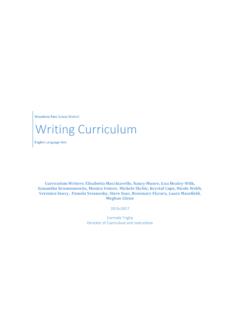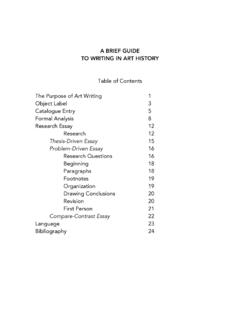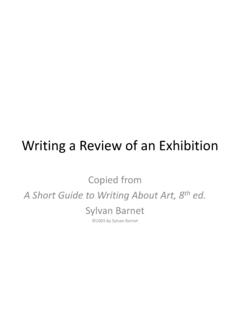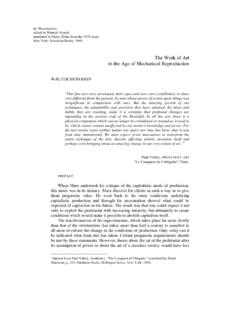Transcription of A. Basic Format Requirements - Department of Art and Art ...
1 art history writing Guidelines Colorado State University Department of Art (revised September 2006) The following guidelines have been prepared for use in all art history classes at Colorado State University. You are expected to adhere to correct Format in such Basic skills as spelling, punctuation, and sentence structure. The following guidelines refer to both Basic writing skills and general paper Format specific to art history . They are based on the guidelines published in the Chicago Manual of Style, the style preferred for art history publications. The CM is available in hardcopy in the Reference section at Morgan Library.
2 Information about documentation is also available online: A. Basic Format Requirements 1. Papers are typed, printed on white paper, and double-spaced with one-inch margins on one side of 8-1/2 x 11 inch paper in 12-point type, Times Roman or equivalent. Do not justify the right-hand margin. 2. Papers start with a separate, unnumbered title page with class name, number, and section number if applicable. The title page also should include your name, date, and the title of the paper. The title page does not count in the overall page count. 3. Pages must be numbered consecutively. Page one begins on the page following the title page.
3 4. Use indented paragraphs. Do not drop a line between paragraphs. 5. Papers are stapled or secured. No plastic binders or covers should be used. B. Documentation: Notes and Bibliographies Most art history research papers will require that you consult primary and secondary sources. Any arguments, ideas, and insights of others, as well as direct quotations and paraphrases of another scholar s words or ideas from articles, books, or any other source require a citation in a footnote or endnote. In other words, if you take wording, phrases, whole passages, ideas, or the logic of an argument from someone else you must acknowledge your source.
4 To not do so is to plagiarize, a serious academic offense. Primary sources include the works of art themselves, as well as literary and historical documents including autobiographies, diaries, letters, account books, and eyewitness accounts or descriptions from the time period under study. Secondary sources are scholarly analyses which take as their subject these primary source materials. 1. Notes: Footnotes and Endnotes Footnotes are placed at the bottom of the page where the citation is made. Endnotes are listed on a separate page that follows the last textline of your paper, and precede the bibliography.
5 Endnotes are double-spaced between entries, flush left. Choose one or the other. Either form is acceptable (unless otherwise stipulated by your professor). a. Format : Footnote or endnote numbers in your text must be consecutive and indicated in superscript (a raised number: 5 ) in your text. The note number usually comes after the final punctuation of the sentence. Do not drop a line between footnotes/endnotes, and do not add extra space before and after footnotes/endnotes. Microsoft Word does all the formatting for you. If you unfamiliar with Word s program, please be sure to familiarize yourself with it before beginning to add in your notes.
6 For example: As Franz Marc wrote, It is like a premonition of this war, horrible and shattering. I can hardly conceive that I painted it. 1 (Later he would write about this quite differently.)2 b. Annotated footnotes (content footnotes) are used to give additional information that is not essential to the thesis of your paper and might detract from the flow of the argument, but that is still important enough to refer to. Use these judiciously, as they can be distracting to the reader. c. Abbreviations: The following abbreviations are commonly used in art historical footnotes: trans. for translated by, ed.
7 For edited by, exh. cat. for exhibition catalogue, rpt. for reprinted. d. Sample note formatting: The very first reference to a source is cited in full. Subsequent references to that source are then shortened (see discussion below). Please take careful note of punctuation! Books: 1 Carl Woodring, Nature into Art: Cultural Transformations in Nineteenth-Century Britain (Ithaca, : Cornell University Press, 1989), 23. 2 Stephan Lackner, Max Beckmann (New York: Harry N. Abrams, 1991), 56. Journal Articles: 3 Timothy O. Benson, Mysticism, Materialism and the Machine in Berlin Dada, Art Journal 46 (Spring 1987): 49.
8 4 Richard Bolton, Art as Education, New Art Examiner 20, no. 5 (January 1993): 12. [[Note that for journal articles, page numbers in the footnote or endnote citation refer to the specific page cited; in the bibliography, page numbers are inclusive of the entire article.]] Chapter in an edited volume: 5 Eduardo Matos Moctezuma, Sahag n and the Ceremonial Precinct of Tenochtitlan, in Representing Aztec Ritual: Performance, Text, and Image in the Work of Sahag n, ed. Eloise Qui ones Keber (Boulder: University Press of Colorado, 2002), 49. Exhibition catalogue: 6 Sidra Stich, Made in : An Americanization in Modern Art, the 50s and 60s, exh.
9 Cat. (Berkeley: University of California Press, 1987), 157-158. Annotated or content footnotes: 7 Stan Brakhage, Metaphors on Vision, Film Culture, no. 30 (1963), 120. Brakhage wrote this essay as early as 1960. Viola discovered the films of Brakhage, Hollis, Frampton, Michael Snow, and others while he was a student at Syracuse. 8 See Stephen Bann, Paul Delaroche: history Painted (Princeton, : Princeton University Press, 1997), 118, who notes Delaroche s attempts at reform of the Salon jury system which failed in 1834 and, again, in 1836. He resigned from the Salon jury, as did Horace Vernet.
10 Electronic sources: 9 Hugh Elton, Byzantine Warfare, Warfare in the Ancient World, 4 April 1999, (accessed 23 April 1999). < ~ >. (Please note: Your computer program may automatically underline the website address, so either use the underline or use < > to indicate the site address. Also, the first date is the day the site was created or last updated, and the last date is the day you used the site.) Shortened citations in footnotes and endnotes: The first reference to a source in footnotes/endnotes gives the entire citation (see above). Subsequent references may be shortened to just the author s last name, followed by a comma and the page reference.







